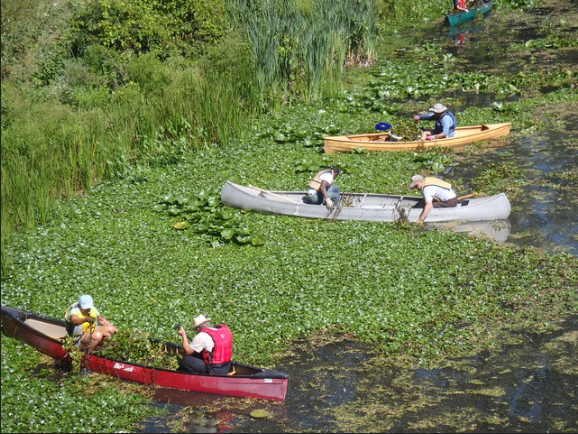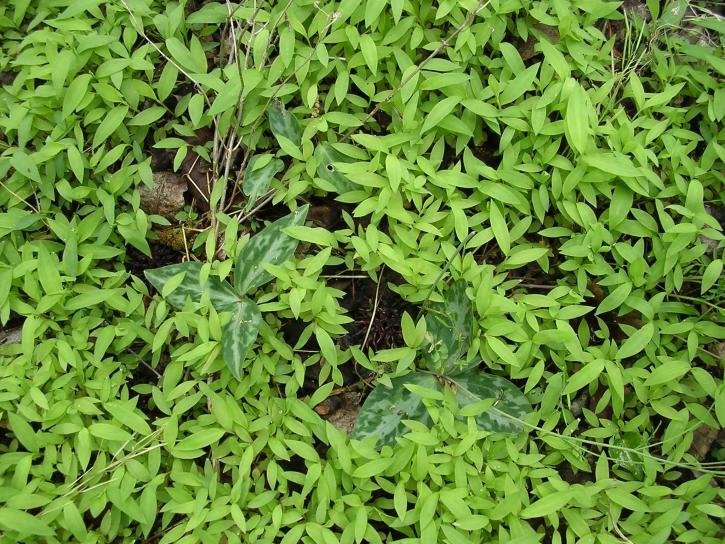The aggressive visitors in the ecosystem: Invasive species

When the latter happens, such organisms become a serious threat to the ecosystem. They spread at a very fast rate within a short period by outcompeting the native species. Such organisms are referred to as invasive organisms or species in ecology.
Native organisms ordinarily do not become invasive unless something extraordinary happens, such as when they suddenly find themselves in a different micro-ecosystem within the same nativity. Even when circumstances occur in which native species show invasive characteristics, they are biologically not attributed to be invasive. In other words, invasiveness is a term that is used for exotic species only - the visitors. This posture, however, might change as time goes by as we all know that science is a dynamic subject.
Effects of Invasive species
When a species is introduced to an environment where it does not grow naturally, establishes itself, out-competes the species that grow naturally in that same environment thereby completing the attribute of invasiveness, the effect it poses can be classified into two:
- Economical or direct effects
- Environmental/ecological or indirect effects
The economic effects of invasive species can be felt in terms of the nuisance they create in the environment. The direct or economic impacts include the cost incurred in their management, such as trying to curtail their spread in the environment through mechanical (physically removing), biological (use of predators), or chemical (agrochemicals) means. Other direct effects include the cost incurred in researching and monitoring them, reduced yield of crops in agricultural settings, reduced exports and foreign exchange generation, and so on.
The ecological or indirect effects of invasive species can be felt in terms of the functions and services the ecosystem provides. While ecosystem services include the various services to man that the ecosystem provides such as pollination, provision of food and watershed protection, regulation of climate, socio-cultural functions, among many others; the ecosystem functions has to do with the interaction of various parts of the ecosystem to bring about the various services rendered to mankind.
When an environment gets invaded by a visitor, the various functions and services rendered by the ecosystem become disrupted and the ecosystem might never return to its original equilibrium even if the invasive species is dealt with and successfully overcome.
Strategies of invasive species
Even though their strategies may vary, virtually all invasive species have a couple of attributes in common which enable them to become dominant in whatever environment or ecosystem they find themselves in. Some of these attributes include:
- Phenotypic plasticity: simply defined as the inherent ability to adapt to diverse environmental conditions, this attribute ensures that invasive plants are able to acclimatize to and establish themselves in a wide variety of environments. When conditions are harsh, their propagules hold the fourth and as soon as a smell of good conditions gets into the air, they germinate and bloom.
- Rapid growth, reproduction, and sophisticated dispersal mechanisms: most invasive plant or animal species have the inherent ability to reproduce and grow at a very rapid pace as compared to other species in the environment. As such, they quickly overshadow and dominate other species found in the same environment. In addition, they produce a lot of propagules or offspring which are dispersed far and near. Many invasive plants such as Chromolaena odorata and Tithonia diversifolia are annual herbs with high reproductive capacities. Their seeds have winds and are very lightweight. Thus, they can be carried to a far distance by the wind.
- Allelopathic: the production of inhibitory substances to limit competition in the environment. Many invasive plants have been found to release chemicals that inhibit growth or outrightly kill other plants within their vicinities. This ensures that only their species survive and dominate the environment.

In addition to the above attributes, many invasive species are usually of one or two uses to man. This utility makes it one of the reasons they are transferred to an entirely new environment and where they get established either deliberately or otherwise.
Final words
Invasive plants or animal species are inimical to the ecosystem and are usually capital intensive to manage. The best way out is to limit the importation of species from one ecosystem to another or curtail any species that shows early signs of being invasive.
Are there invasive species in your country? Feel free to share in the comment section.
Than you for reading.
I was lucky enough to work with several invasive species, such as Lepna, Ploceus cucullatus, algae, for example, cause a decrease in O2 in the water, killing many animals because they do not allow sunlight to penetrate the bottom!
Yea...the algal bloom. Those obnoxious, foul-smelling nuisances. But can we actually say algal blooms are caused by invasive species rather than eutrophication?
This is a very interesting topic.
I live in New York (the more country part of it, it's mostly wilderness here contrary to popular belief.)
I am a fisherman and we have this creature here called a Snakehead. It will kill everything in its path and is not native here.
https://www.dec.ny.gov/animals/45470.html
At the bottom of this article, the advice is to kill it immediately if catching one and report where it was caught with photos.
I've never caught one, but I have caught fish that had been attacked by them, and let's just say they were lucky to have survived the brutal attacks of these things.
Great article, thank you for sharing!
I never had this knowledge about New York. Use to it its mostly urban with high-rise buildings. Just imagine! See how the snakehead got into the aquatic ecosystem of New York. I am certain no harm was intended but the fish had other plans. If this could happen for a fish, imagine how invasive plants can come about.
Thanks for sharing that link with me, it is an interesting read.
https://twitter.com/gentleshaid/status/1411396543492542474
The rewards earned on this comment will go directly to the person sharing the post on Twitter as long as they are registered with @poshtoken.
Thanks for your contribution to the STEMsocial community. Feel free to join us on discord to get to know the rest of us!
Please consider supporting our funding proposal, approving our witness (@stem.witness) or delegating to the @stemsocial account (for some ROI).
Please consider using the STEMsocial app app and including @stemsocial as a beneficiary to get a stronger support.
Actually I've worked really hard on different invasive species not only plants but also animals here in the Portland area for eradication.
One of the biggest mystery ones is the nutria population out here which happens to be really large rodent of unusual size.
Yep that's right that's also what I think was the animal we were referring to in the princess Bride.
However it has very large habit of destabilizing the Amazon rainforest which actually is needed because of the massive floods..
Our friend our environment destabilization of riverbanks causes massive amounts of erosion.